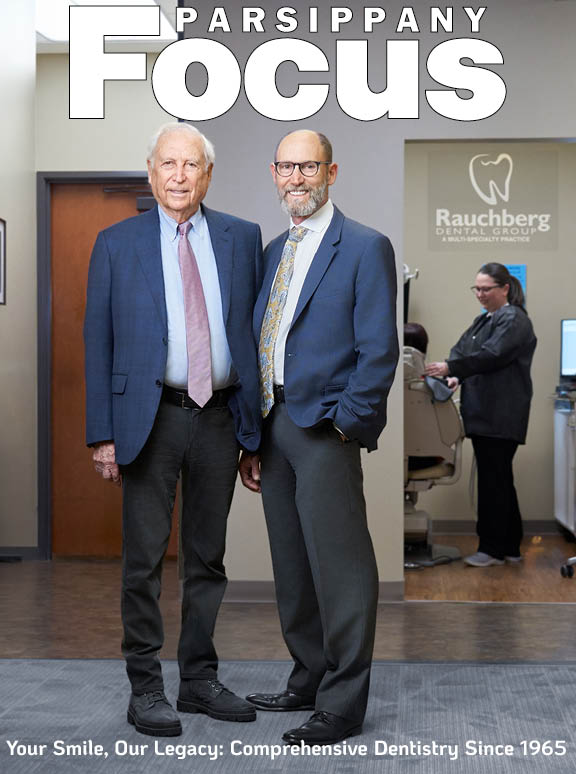PARSIPPANY — A group of residents appeared at the Parsippany-Troy Hills Township Council meeting on Tuesday, December 7 to ask questions of Mayor James Barberio and Council members on the Project Labor Agreement (PLA) decision.

Parsippany resident Annette Terrone said, “I am one of the many residents who signed the petition against the PLA. I believe PLAs are wrong for Parsippany taxpayers. Research has shown it is not competitive, discriminatory against non-union workers, and costs seem to be higher. Hopefully, fair and open competition without a PLA will help taxpayers get the best possible product at the best possible price. A friend who is also a resident of Parsippany and could not make it here tonight is also against the PLA and asked me to bring this question to you. What created the need to limit the bidding process to union contractors? Have there been examples of non-union contractors that performed substandard work? Was that the reason to exclude them from the bidding process? And if it was, he would like to know examples. If there was no problem with non-union contractors, what is the reason to exclude them now? So I’ll just present that to you from another participant resident. Thank you for listening.”

Elaine Gavalagas, a Parsippany resident of 28 years said “I have done and will continue to do my own research on PLAs. Articles that I have read, showed studies that were done on PLAs as having higher financial final construction costs and longer project completion. This is not missed or misinformation, they are actual studies that were done. This is a learning experience for me as I seek to become more informed. I have a few questions that I would like answered. If they cannot be answered now, I would like a date as to when they can be answered. Does Parsippany expect lawsuits to be filed by non-union contractors when they are exempt from bidding on work? What impact will the PLA have on the Lake Hiawatha Library? Those are the two questions. I understand that there is a petition going around and I would just like to know what it will take for you all to listen. I’m not sure who it was, but someone on the council said that they didn’t know that the 200-plus union members at that meeting at the high school would be there. How could you not know? There were tables set up outside and there was a truck with a picture of Justin on it. Not intimidating. There’s no pride left in Parsippany if the PLA is not repealed.”

“I looked online about a website that’s called TruthAboutPlas.com and it mentions under state and local construction an article saying that the African American Chamber of Commerce of New Jersey speaks out against PLAs. I also noticed a lot of words like reduced competition, increased costs, wasteful and discriminatory, expensive, and inflationary. And regarding the Lake Hiawatha Library, I live near there and $9 million is an awful lot of money. So I’m hoping that these things are not gonna escalate, especially with the PLA. I would like to see it be repealed because I know from a fact that I used to work at the US Army in Picatinny and I dealt with contracting and I could see some of the spending going on there. And there’s a lot of spending that sometimes goes overboard and costs overruns and stuff like that. So I’m concerned about that as a taxpayer and resident of Lake Hiawatha,” said Ray Gallup.

Parsippany resident Yvonne Fara said “I’m here because I totally disagree with the PLA ordinance for three reasons. One is because it’s not good for the town. It’s going to harm the economy of the town. It’s going to eliminate competition. And more important it is going to harm the Parsippany taxpayers. I’m a homeowner in this town. I am very disappointed because we elect you to protect the homeowners and taxpayers, and you are not doing that. Then another reason why is Parsippany the first in Morris County that approved this.”

Parsippany resident Bob Venezia said “At the last meeting, council member Justin Musella introduced a petition to repeal the PLA ordinance citing studies that have demonstrated that PLAs increase project costs by 33% and slow project timelines by six to eight weeks. The mayor’s immediate reaction was that the petition was based on misinformation. His reason is, The study by the New Jersey Department of Labor that produced these cost and time results was published in 2010 and is now outta date. However, there have been no subsequent studies by any entity contradicting the results of that study since it was published. In fact, there are more recent studies that they may or may not be aware of, which corroborate the results published by the New Jersey Department of Labor. One such study was documented on October 22, 2022, Daily Record article entitled, ‘Should New Jersey Town Steer Public Projects to the Union Labor:’ Parsippany the Latest to Take Up the Debate.’ Here’s an excerpt from that timely article, “A 2019 analysis by the Beacon Hill Institute. A Massachusetts economic researcher concluded that PLAs resulted in significantly higher costs for school construction in Ohio, Massachusetts, Connecticut, and higher final bids in New York.” A petition is a non-binding way for residents to express their opinion to the governing body on a particular issue. In this case the PLA ordinance. So any taxpayer who would like to express to their representatives that they are unwilling to pay a 30% PLA project surcharge, which translates to an extra 1.5 million or more for each 5 million projects should seriously consider signing Councilman Musella’s petition.” (Click here for information on the petition).

Hank Heller said “I think most of you know me. I come here as a friend, not as an adversary, and I’d like this leadership to be able to continue leading Parsippany for many years to come. But with that in mind, I’d like to point out some things that I think are important. I’d like to be helpful. I do not expect that any of you will tell us who it was that invited the union people to come and sit amongst us and, frankly, common force. I’m only bringing it up because I think it was a very, very bad idea and whoever it is that brought us this largest, in fact, did not do you nor any of us a favor. Okay. So I’d like to keep that in mind, for whatever comes into the future in our community. We don’t need outside people coming and, boisterously trying to steer us into making our comments into what they would like them to be. It’s just not the right thing to do. As a former banker in New York City, I’ve had strong relationships with senior construction executives in some of the very largest companies, who are in the construction field in New York and throughout the country. One who I worked with also taught at Cooper Union College. He taught construction management. And I called and asked him what he thought about this PLA situation and what he explained to me as I think it would be useful for us to think in these terms. They use PLAs and unions in, New York City, for example, in large municipalities because when you’re building a 50 or a hundred-story building, we’re talking about hundreds of millions if not billions of dollars. And you have many large participants who are putting forth that funding and they are not nearly so interested in the lowest cost but in the lowest amount of risk to themselves and to their own bottom lines. And that is why so often you’ll find large projects are going toward unions and PLAs, because it gives, and spreads out the risk, so to speak, in a municipality like Parsippany. We don’t really have very much of that, certainly not in the municipal buildings. For that reason, I think that it’s very important that you guys rethink what it is that we’re doing and how we’re doing it. I understand how it could be useful in some cases, but in this situation where we’re facing, huge increases in insurance costs for our municipal employees and worry about how we are going to fund that. And I understand that we are looking at large increases in our sewer and water taxes. I think it’s very important that you rethink what, it is that you’ve put forth and come back and help your, voters understand why what you’re putting forth is useful to us and will help to mitigate our course rather than increase our costs because that’s what we’re facing with the insurance costs and water and sewer costs besides. That’s what I really want you to think about. Please help us to understand what you’re doing is good for us, not bad for us, because most of us don’t really think that it’s useful and helpful to us.”

After the public session ended Councilman Frank Neglia read a prepared statement:
First, let me say this man next to me (Mayor Barberio) loves this town and would never do anything to hurt it. He does his research and makes decisions to help the town. He would never misuse the people’s trust and never mislead them. He certainly wouldn’t use propaganda to promote his cause. He’s one of the most transparent people I know and he’s honest. That being said I’d like to speak about the PLA and what I found in the research I did. I’m not going to use propaganda or hype to support what I’m about to say, just facts and what I found in my research as I promised various residents I would do
Please bear with me some items may be repetitious
A project labor agreement (PLA) is a pre-hire collective bargaining agreement with one or more labor organizations that establishes the terms and conditions of employment for a specific construction project.
It could be a Union or Non-union agreement. Anything said to the contrary is false
PLAs are effective mechanisms for controlling construction costs, ensuring efficient completion of projects, and establishing fair wages and benefits for all workers. PLAs also help ensure worker health and safety protections while providing a unique opportunity for workforce development.
The Davis-Bacon Act covers any federal projects. The NJ Prevailing Wage Act covers any municipal buildings and school buildings. The threshold for these projects, is $2,000.00 on board of ed buildings, and $ 16,263.00 on Municipal buildings. (this can be confirmed on the NJ Dept of Labor website)
These wages are set by the State and must be paid to all workers, 229383union or non-union.
Safety regulations, using local workers, and no strike agreements, do not add costs to the job.
A PLA is a pre-hire collective bargaining agreement made that establishes the working conditions and contractual terms before a project breaks ground. All costs are included.<
PLA is intended to control costs, increase quality, and ensure that projects are completed on time.
What Positive Aspects of Project Labor Agreements?
Setting expectations in advance, there are several upsides to project labor agreements. The potential benefits are as follows:
Strikes, lockouts, and other interruptions to labor are not permitted under a PLA.
Improved efficiency results from conditions being decided in advance.
When there is a dispute, PLAs encourage conflict resolution such as arbitration and mediation.
Safer working conditions: Health and safety conditions are made a priority.
To Reiterate the benefits of a project labor agreement?
PLAs are effective mechanisms for controlling construction costs, ensuring efficient completion of projects, and establishing fair wages and benefits for all workers. PLAs also help ensure worker health and safety protections while providing a unique opportunity for workforce development.
PLAs bring order and specific responsibility to public construction projects. They are binding agreements that call for collective bargaining between labor and contractors. In addition, they define the terms and conditions applicable to all workers — union and nonunion — on public construction projects.
It’s what they deliver — an agreed-upon concerted outcome — that makes them so effective. They provide stability to larger construction projects while ensuring compliance with workplace safety and health laws, wage protection, and equal opportunity.
PLAs have existed since the 1930s because their components provide cohesion to each project, including stability and predictability, diversity, local jobs, and training and advancement.
LAs add order by clearly defining each contractor and craft worker’s responsibility. No hidden cost. They address labor issues, designate cost standards, prevent shutdowns, and are mindful of maintaining completion schedules. PLAs provide coordination and leadership to this process while acting as a mediator to prevent any disputes.
Diversity and local jobs
Nothing helps a project gain allies with public officials and the community at large like promoting the hiring of workers that are local constituents. This is true of PLA. The PLA MUST hire 20% of Local/Parsippany residents. Not those that are illegally in our country or citizens of other countries like other entities allegedly promote.
And when a project can attract women or minorities, both of whom the industry has underserved, their enthusiasm increases.
Unlike what you have been hearing from someone, PLAs can vigorously encourage hiring efforts from small businesses, minority contractors and local workers while emphasizing government-required safety training. For example, a PLA can stipulate that a worker has undergone and obtained OSHA certification. This reinforces the “safety first” attitude of the workers and reduces accidents.
Training and advancement
Most contractors want the most highly skilled, well-trained worker available. PLAs pay considerable dividends by preventing costly errors and accidents because of their emphasis on training. Union carpenters, for example, spend a minimum of four years with in-class and real-work experience before becoming a journeyman. Continued education classes after graduation keep them abreast of the newest trends, materials, and potential new skills.
Myths about PLAs
Some anti-PLA rhetoric denounces these agreements by spawning myths. They include:
PLAs apply only to union workers. False. They apply to union and nonunion workers, and they don’t mandate that workers must join a union like some are saying
Some critics claim that PLAs reduce the number of bidders on public projects, thus raising costs. So False. A 2020 study in the Public Works Management & Policy journal reviewed 263 bid openings for community college construction from 2007 to 2016. This first-ever study of its kind concluded that the presence or absence of PLAs did not alter the number of bidders on a project or increase the cost.
Some critics say PLA’s increase your Taxes. AGAIN VERY FALSE. You send out a bid spec, get the proposals from both Union and non-union entities and that’s the cost. There are no hidden costs. That’s what a bid is. Some people may be hearing differently but this is the truth
We ask ourselves why do PLA myths exist, and why certain companies object to using them. It’s simple. Because some companies want to reduce the competition, hire unskilled workers, pay under-the-table to non-skilled workers, and price gauge the customer with extras. This is a common practice of non-PLA projects. I’ve been a Facility Director and property manager for over 30 years and have seen it firsthand.
Without PLAs, Vendors can skirt hiring mandates, disregard the need for certified skills among workers, and ignore efforts to provide job opportunities or training for women and minorities.
Yet all these reasons pale against the most frequent motivation: worker exploitation, which is widespread in the construction industry and needs to stop!!.
The unethical practice of paying below-standard wages or paying workers off the books is eliminated when entities utilize a project labor agreement.
The core value that PLAs offer is transparency.
It is a public document. Anyone can review it — municipal officials, organizations, construction companies, and the general public — to assess whether the agreement is fair and makes sound business sense.
Indeed, it raises the obvious question of why anyone would not support a PLA.
This council voted 4-1 to support the mayor’s recommendation to use a PLA on Projects over 5 million.
We did so because we consider it to be the fairest, most transparent, and most productive approach to conducting business in the construction industry while benefiting taxpayers, municipalities, construction businesses, and workers. Thank you”

After Councilman Frank Neglia finished, Councilman Justin Musella then fired back.
“First and foremost, I truly do appreciate my colleagues, information, and new evidence. I am really glad that we’re having this dialogue. It’s unfortunate that this dialogue didn’t happen before we voted on this. And there’s a couple of things in there that I think is really important for the public to be aware of. There’s been this claim, and I don’t know why we keep saying it, because, in the actual ordinance, it spells it out correctly. This ordinance, the project labor agreement, does practically nothing to hire local Parsippany residents. I don’t know why we’re saying 20% of Parsippany residents will be hired. So I pulled up the ordinance that we all voted on, and I’m gonna read it into the record as I’ve done multiple times. The ordinance says it requires that 20% of the labor hours required shall be performed by the Parsippany-Troy Hills residents who are participating in the apprenticeship program. And that 100% of the apprentices shall be Parsippany-Troy Hills residents. So I did some digging to find out in actuality, how these provisions end up playing out in the real world. But how they end up playing out in the real world is that apprentices who are local residents end up getting recycled over and over again, so that way they can fulfill that hours component that’s in the ordinance. So if we’re telling people that 20% of the residents will be hired under this ordinance. The ordinance flat-out contradicts that. I understand some of the points that were made about how PLAs actually promote efficiency. Well, if you read PLAs, can somebody explain to me how work jurisdiction promotes efficiency? How does segmenting who shall do certain work, whereas, contractors who don’t have to abide by a PLA can have their employees perform all tasks at once? How are we protecting the taxpayer with minimum show-up time where if somebody shows up to a job, they have to be paid for a mandatory amount of time, regardless of not whether or not they’re productive on all of your expenses? So these are the questions and I’m glad that we’re having the dialogue and the debate I appreciate my colleague saying what he believes in, but PLAs are flat-out bad public policy. And the overwhelming body of evidence that has been conducted on this issue is crystal clear. They raise project costs, they are anti-competitive and they harm small businesses. So I appreciate my colleagues’ information but I don’t believe that’s gonna change many minds as over 800 residents disagree with that?” said Councilman Justin Musella.
Click here to download a copy of the Ordinance 2022:24.
On October 18, the Parsippany Township Council voted 4-1 to mandate blanket project labor agreements for all township capital projects over $5 million.
Click here to watch the video of the meeting.
















